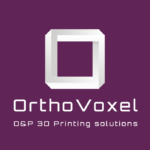Why use supports for RTV-2 silicone 3D printing?
RTV-2 silicone elastomers used in additive manufacturing are used to produce flexible parts with complex geometries. Silicone 3D printing is common in prototyping and small series manufacturing. These two-component silicones have the particularity of being printable in liquid form.. The contact of these two components initiates a reaction catalyzed by platinum without generating volatile compounds. Their cross-linking by polyaddition will allow the final realization of the 3D part. They are suitable for the medical sector, especially for skin contact application in external orthopedic devices.However, due to their fluid characteristics, parts printed in silicone elastomers are more complex to print . Parts made with structures that have an overhang of more than 45° or a bridge of more than 5 mm in length are therefore more subject to potential collapse. To minimize the impact, we recommend the use of a substrate to support the printing of the part.
The different types of RTV-2 silicone 3D printing support
Printing of rigid (detachable) or soluble structures
The use of a rigid structure as a support during printing requires a multi-material printer or printhead. For example, one nozzle will print a rigid support structure and another nozzle will print the silicone. The structure is then printed as a lattice or a tree. In theory, it is also possible to print the support structures in silicone, but as these will cross-link with the part, they will have to be removed by cutting, which can greatly alter the final quality of the part. On the same principle, it is possible to extrude water-soluble materials.H2 : Printing in powder bath
Printing in powder bath
The use of a rigid structure as a support during printing requires a multi-material printer or printhead. For example, one nozzle will print a rigid support structure and another nozzle will print the silicone. The structure is then printed as a lattice or a tree. In theory, it is also possible to print the support structures in silicone, but as these will cross-link with the part, they will have to be removed by cutting, which can greatly alter the final quality of the part. On the same principle, it is possible to extrude water-soluble materials.H2 : Printing in powder bath
Solution: use of a support gel
The use of a gel as a support material is a solution that has recently appeared on the market. It is proving to be an excellent compromise for dealing with collapse issues. This non-reactive substrate, if used as a bath, maintains the structure of the 3D part being printed and smoothes its surface. Once the part is cross-linked, it can be removed from the bath and rinsed with water without further post-processing.
Our solution : COPSIL 3D® ADD-GEL
Our new support material for RTV-2 silicone 3D printing is the COPSIL® ADD-GEL. Based on our expertise in polymer chemistry, it facilitates the production of more complex parts by freeing you from geometric constraints. COPSIL 3D®ADD-GEL support gel has been tested on Lynxter’s LIQ21 two-component liquid toolhead and S600D printer with and with the Fisnar QuantX™ 8001109 needle. The results demonstrate excellent properties to support complex structures. Its transparency allows monitoring and checking the parameters of the printing in progress. Chemically inert, our product is easily cleaned with water.
How to use it ?
Our COPSIL 3D®ADD-GEL is ready to use with our printable RTV-2 silicones COPSIL 3D®. In addition to a 3D printer with a two-component liquid printing toolhead, you will need a vat with a flat surface and a mixing tip fitted with a needle. Designing with the support gel requires some specific knowledge. To assist you, we have created a guideline available with our COPSIL 3D® ADD-GEL.
Go to this page to access :
https://cop-chimie.com/en/guide-de-conception-copsil-3d-add-gel-2/
Our 3D printing silicones
We have developed a range of COPSIL 3D® silicone elastomers for the manufacture of flexible parts with complex designs or for prototyping. With a platinum-based catalyst, these materials cross-link at room temperature by polyaddition. Our company offers several references according to the hardness required:
H1 : COPSIL 3D® in the orthopedic sector
Printable RTV-2 silicones are used in external orthopedic devices such as hand orthosis, orthopedic inserts, etc. Indeed, they are skin contact certified (ISO-10993-5) and provide support and comfort to the patient. They are chemically inert and provides support and comfort for the patient.










